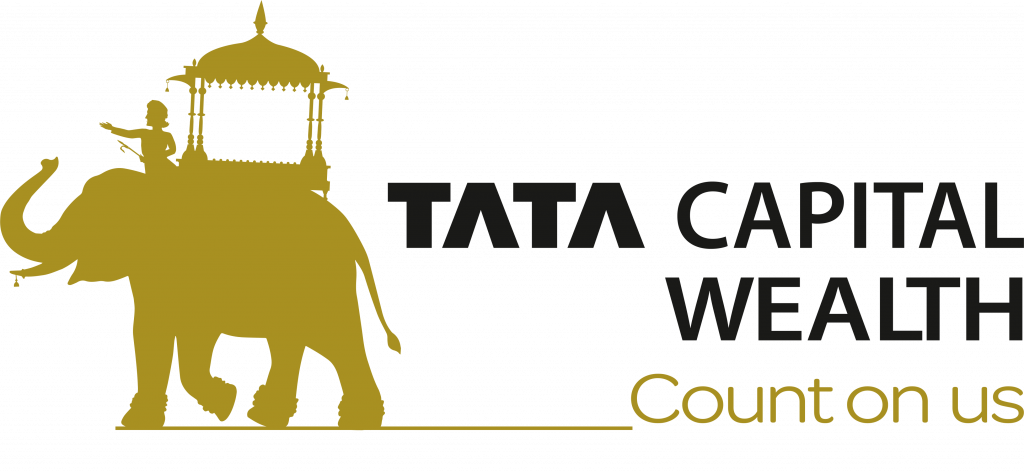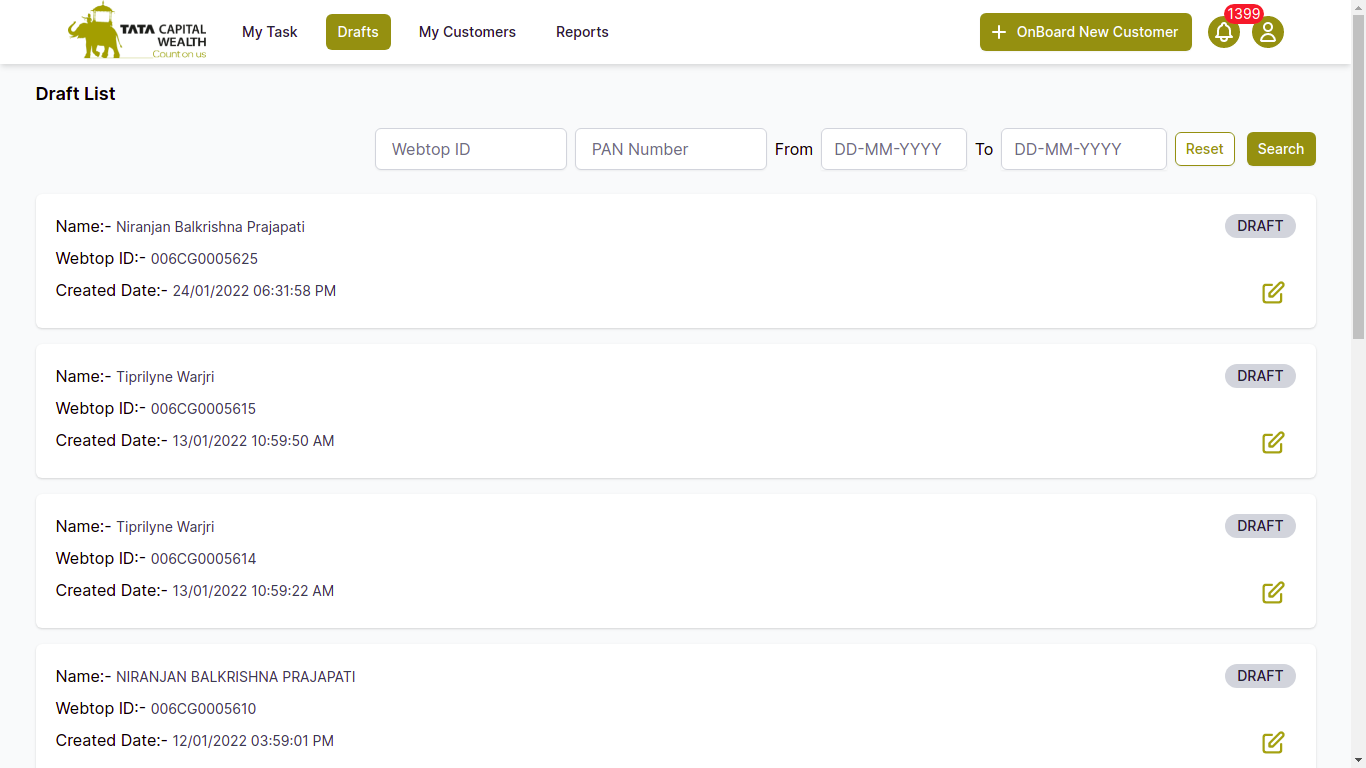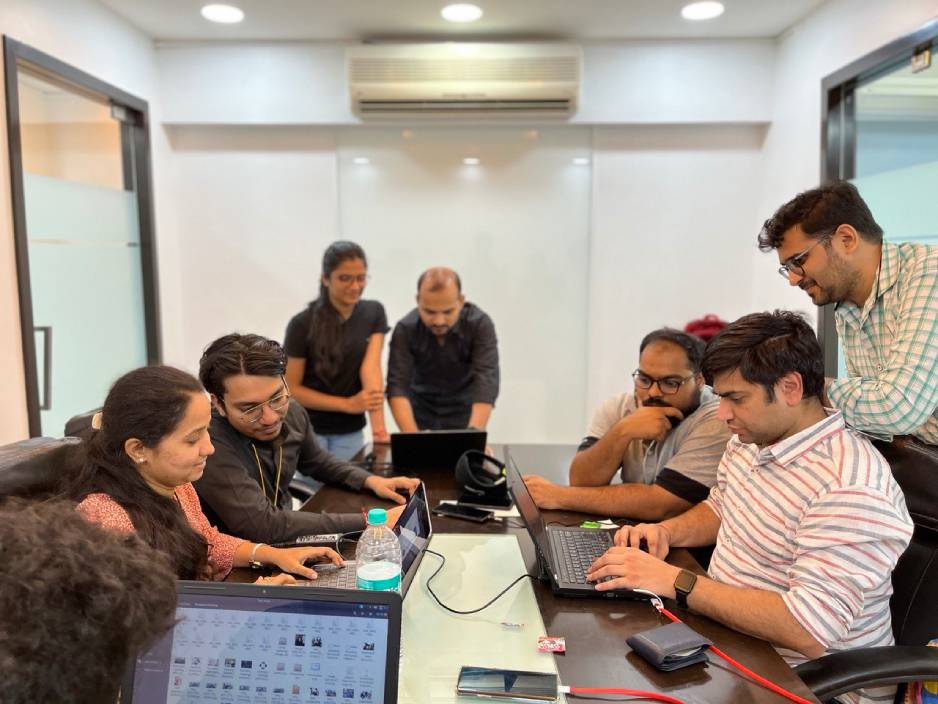Tata Capital Wealth Online Onboarding
Tata Capital Limited (“TCL”), the flagship financial services company of the Tata Group, is a subsidiary of Tata Sons Private Limited and is registered with the Reserve Bank of India as a Systemically Important Non-Deposit Accepting Core Investment Company (“CIC”).


About The Client
Tata Capital and its subsidiaries are engaged in providing/supplying a wide array of services/products in the financial services sector and operate across various areas of business: Commercial Finance, Infrastructure Finance, Wealth Management, Consumer Loans, and distribution and marketing of Tata Cards.
The Project
Tata Capital Wealth Onboarding is a sophisticated system created for Tata Capital Wealth that automates the process of onboarding their customers by their sales team thus helping reduce the time taken by the manual process by 80%.
Technology Selection
Wealth onboarding includes various levels of validations for customer information and the complex workflow nature of the processes and translating it into a user-friendly responsive web application which is stable, sturdy and can be managed easily.
After measuring the positives & negatives in context to process, workflow and considering the sturdiness and durability of the application, we came up with a stack that can be used to build responsive web applications and make the creation of applications secure, easily scalable, manageable and long lasting.
Going with the technology trends while also keeping in mind the requirements and the needs of the client we went ahead with ReactJS as a framework for developing the end product & Java Spring Boot infused with BPMN process modelling compared to other technologies.
The Challenge
Wealth onboarding not only involves collecting information & documents from the customers but also to understand the levels of processes through which the information travels before the customer is finally onboarded.
The challenge here was to understand the working of different types of verifications that are required ( i.e. NSDL, Aadhar OKYC, CVLKRA, etc). Also to understand the workflow through which the information & documents collected from customers will flow and create a system which seamlessly integrates all the above, making it easy & flexible for the customers and workflow teams to use the application.
The primary selection criteria were based on a few key factors.
ReactJS:
Reusable Components
ReactJS web applications are made up of various components, each component has its own logic and controls. These components are responsible for producing a small, reusable piece of HTML code that may be used anywhere needed. The reusable code simplifies the creation and maintenance of your apps.
Performance Enhancements
Reactjs uses Virtual DOM as the name implies, a virtual representation of the DOM. Any new view changes are first performed on the virtual DOM, which lives in memory and not on your screen. An efficient algorithm then determines the changes made to the virtual DOM to identify the changes that need to be made to the real DOM. This guarantees a minimum update time to the real DOM, providing higher performance and a cleaner user experience all around.
One-Way Data Binding
One-way data binding model also ensures that changes in the child component do not impact the entire code. So, when you type a text in the input field, this model just updates the data model. And this is how one-way data binding makes code more stable for both application and web development.
Strong Community Support
The framework for web development is ReactJS. A major contributing factor is the strong community support React developers get from all around the world. In addition, experienced developers share insights about applying this framework in the form of blogs, in-depth articles, tutorial videos on popular forums.
Used by Global Companies
Due to all the above-mentioned key features and many more. ReactJS is the go-to choice for many global companies like the names of Facebook, Instagram, Twitter, Netflix, Whatsapp, Atlassian, Dropbox, New York Times, Tesla, Github, Paypal, etc.
Java Spring Boot:
Mature Framework
Spring Boot is based on the spring framework of Java, which was released in 2002. With nearly two decades of Spring-based development in the market, the choice of Spring Boot serves as a mature option to go for. However, Spring Boot is an extension of the spring framework, with pre-configurable web starter kits facilitating the application server.
Security
Spring Boot itself is a well-secured framework and considered safe from most cyber-attacks as it is a part of Java Spring. The framework is secured to cross-site request forgery, where a hacker can manipulate the entire working of the app to chat with users.
Fortunately, Spring comes with default security against a CSRF attack, thus keeping your business website or app safe and secured. The developer’s team can enhance the safety of the project in multiple ways when using Spring Boot.
Auto Configuration
Autoconfiguration is a core Spring Boot approach to reduce the number of actions developers have to take. It automatically configures a Spring application based on dependencies you added before. Spring Boot autoconfiguration offers robust default features while saving great flexibility.
Used by Global Companies
Due to all the above-mentioned key features and many more. The Java Spring Boot is the go-to choice for many global companies like the names of Udemy, Cred, Trivago, Bank of America, J.P.Morgan, etc.
BPMN Modelling:
Align Operations with Business Strategy
Implementing a business strategy or a new business model requires changes in the operations and in how people perform their work. This can be affected only by operationalizing the business changes to the actual business processes, business rules and decisions that are made on a day to day basis by all the people in the organization.
Business Process Modeling facilitates this by helping Link organizational strategy to well-defined business processes, Align business execution and operation activity with strategy, Implement Business Process Reengineering (BPR) by understanding the existing processes and changing them for improved performance, & Enable Process Agility.
Ease of Use
BPMN is one of the most common business process modeling techniques and uses standardized symbols to make process maps easier to understand for all relevant parties: management, employees, and consultants. It offers a standard notation that’s readily understood by everyone.
Improve Operational Efficiencies
In today’s business environment, every business and every manager wants to ensure that they are achieving the best possible results with the resources available to them. There is no room for inefficiencies and wastage.
The Process simulation and analysis steps of Business Process Modeling are critical tools for managers and analysts to ensure that their processes are optimized and are running like a well-oiled machine.
Increase Control and Consistency
Organizations and companies that succeed are ones that ensure their business processes and rules are well designed and that they are consistently applied the same way every single time. This process control and consistency is key for success in organizations ranging from fast-food chains to hospitals to NASA Space Shuttle operations.
Used by Global Companies
Due to all the above-mentioned key features and many more. The Camunda’s BPMN modeler is the go-to choice for many global companies like the names of Universal, Deloitte, ING, Atlassian, etc.
The Solution
Responsive Web Application:
Our solution included creating a web application that can be used on all browsers. The process flow in the web application is created considering the information to be captured from the customers, understanding the workflow journey of a single application passing through different roles of application users for approvals.
The Web App consist of the following processes:
Easy access to the pending/Unclaimed tasks for Manager, Operation, Zonal Head, users.
Secure sending of forms to customers on their respective email or mobile number.
Timeline view of the journey of the form.
In App notifications for quick access.
Various 3rd party validations like NSDL, CDSL, Aadhar OKYC.
PDF generation of the form submitted by customer and email notification to customer on successful onboarding.
Easy to fill information as the forms are divided into the sections.
Easy claiming of forms by the Checkers.
Assignment, Updation, Escalation email notifications to users.
User Level MIS and Application Reports for detailed Analysis.
Integrations with 3rd party services like Miles, DMS, etc.

